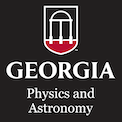Quantum information processing requires our ability to design, build and control devices at the quantum level. I will review our recent work in this direction using elementary building blocks: single electron, single spin, single exciton and single photon. Examples will cover lateral semiconductor and graphene quantum dots as quantum circuits based on electron spin and self-assembled quantum dots for single and entangled photon sources.
Events Calendar View
-
Departmental Colloquium
Mar 3, 2011
Semiconductor and graphene devices for quantum information processing
-
CSP Lunch Seminar
Mar 8, 2011
Novel spin-wave excitations in the nanoscale classical Heisenberg antiferromagnet
-
Departmental Colloquium
Mar 10, 2011
New Insights on Jet Physics
Jets are one of the classic manifestations of the active galactic nucleus (AGN) phenomenon, with the first example having been discovered in 1918: what Heber Curtis described as a "curious straight ray" in the galaxy M87. Today we know that jets are high-energy streams of matter and energy that emerge from the nuclear regions at relativistic speeds and have emissions that are seen from the radio through the gamma-rays. The flows carry with them immense kinetic energy, comparable to the luminosity of the AGN itself, and are now understood to be a transformative force that feeds back into the evolution of the surrounding galaxy and cluster. In this talk, I will concentrate on the physics of jets. I will begin with a review of the field, focusing on structural elements, variability, and the production of high energy radiation. I will then turn to the open questions, emphasizing the unique information that can be revealed by polarimetry. I will then talk about HST polarimetry and Chandra X-ray observations of nearby jets, where we are learning new information about the jet structure and the role of magnetic fields in particle acceleration. Of particular interest will be the M87 jet, where thanks to its proximity, we have been successful in for the first time isolating a violently variable region within the jet. This gives us powerful insight into the physical processes that surround its variability and response to stimuli.
-
Mar 11, 2011
Probe the Phonon-Glass Aspects of Thermoelectric Material by Neutron Scattering
Guest: Dr. Jian He, Department of Physics and Astronomy, Clemson University Clemson, SC 29634-0978
Friday, March 11, 2011 4:00 pm - 5:00 pm
Location: Riverbend Research South Laboratory AuditoriumThe global demand for sustainable energy imposes a pressing need for breakthroughs in alternative energy technologies, including that of direct thermal-electrical energy conversion via thermoelectricity. Despite
many technical advantages, thermoelectricity has long been restricted to niche applications due to a low conversion efficiency. Improvement of this conversion efficiency hinges primarily upon decoupling the otherwise inter-dependent material parameters (resistivity, thermopower and thermal conductivity) as a group to attain a higher figure of merit, ZT. In the last 10-15 years, the synergy of nanomaterials and thermoelectrics has culminated into a new paradigm, “nanostructured thermoelectrics”. By extending the control of charge and entropy transport from the atomic scale to the nanometer scale, the implementation of the “nanostructuring” process may help ease the limitations that arise from the inter-dependence of these material parameters. This presentation will highlight a case study of the Bi2Te3 material. The results of transport property, microscopy and neutron scattering measurements provide new in-depth knowledge that is crucial for the design of higher performance thermoelectric materials.
*This work is support by DOE-EPSCoR. -
Departmental Colloquium
Mar 17, 2011
Spring Break
-
Departmental Colloquium
Mar 24, 2011
Connecting Star Formation, Galaxy Evolution and the X-ray Background
As we now know, the growth of galaxies and their central black holes is connected through some unknown mechanism. The cosmic X-ray background encodes within it the entire history of accretion onto supermassive massive black holes and so provides an unique view of the role of AGN in the assembly of galaxies. This talk presents results of recent work that is attempting to exploit the information contained in the X-ray background (and ancillary multiwavelength studies) to construct a testable scenario for the evolution of AGN and their host galaxies.
Page 19 of 121, showing 6 records out of 723 total, starting on record 109, ending on 114


